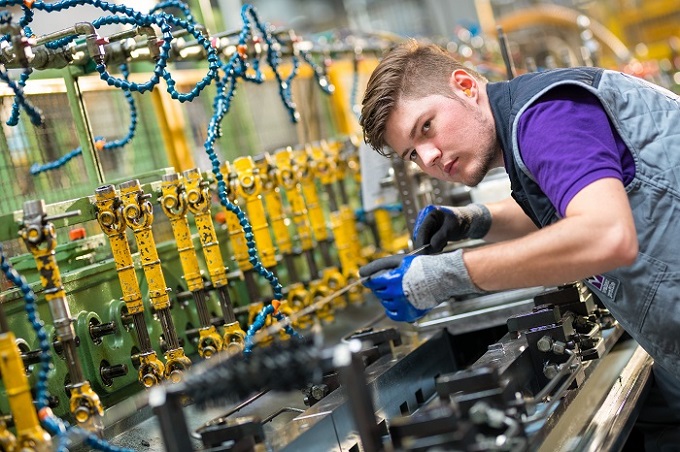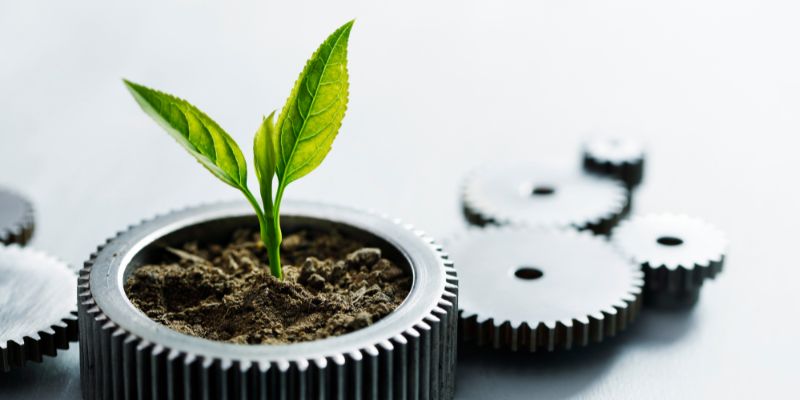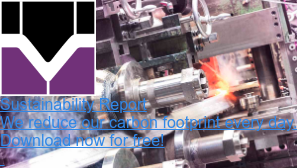Sustainable Product Development: 7 Tips for reducing Waste and CO₂
Joanna should really be concentrating on completing the sketches she needs to submit for the new ready-to-install component. The deadline, as always, has crept up on her faster than anticipated. But her mind keeps wandering. She keeps thinking about the webinar she attended last week, where the speaker explained that almost 80 percent of all product-related environmental impacts are determined in the design phase of a product. So could our intrepid young product developer actually make a greater contribution to combating climate change, the energy crisis and resource scarcity than she previously realized? That’d be a fantastic opportunity.
Motivated and full of ambition, Joanna starts to look into ways of using natural resources and production materials more efficiently to help support sustainable product development. Let’s see what she comes up with.
What is sustainable Product Development?
In addition to the intended functionality of a product, sustainable product development takes into consideration its ecological and social effects. The entire product’s life cycle is considered, from production to disposal. In this sense, the product design should ensure that the necessary resources are used efficiently, and that the materials used are as sustainable as possible.
Sustainable product development doesn’t begin and end with the manufacturing stage. To get an accurate accounting on the sustainability of a product one needs to include: the entire supply chain of the materials up to the finished end product, responsible production methods, minimizing waste and emissions, and promoting recycling measures.
With this bigger picture in mind, there are several promising approaches and possibilities for Joanna to make her product design more sustainable. But she’s realized it won’t be possible with their previous manufacturing partner. So now she has to convince her supervisor to switch manufacturers. But before she puts this request forward, she`d better come up with a few solid arguments. After all, the new solution can’t just be sustainable- it also has to make good business sense if the boss is going to go along with it.
Benefits of sustainable Product Development
Despite the phrase perhaps being almost overused to the point of meaninglessness lately, the pursuit of sustainability can have a lot of real benefits for companies - even more than meets the eye. Here are some of the most important advantages of sustainable product development:
-
Environmental & Resource Conservation through the most efficient possible use of raw materials and resources as well as manufacturing processes that make use of renewable energies.
-
Long-Term Cost Savings through materials that can be recycled and energy-saving production methods.
-
New Business Opportunities, e.g. in markets with growing demand for sustainable products.
-
Reduction of Waste by using recyclable materials or by designing products with a longer service life.
-
Strengthening Customer Trust through the company assuming its responsibility towards society and future generations
-
Increased Efficiency thanks to new production processes and optimizations in the supply chain.
-
New Legal Regulations can be met before they come into force through forward-looking action and active efforts towards sustainability.
-
Increased Company Value thanks to a higher brand attractiveness for forward-looking investors.
- Strengthening Innovative Power through incentives for developing environmentally friendly and resource-efficient technologies.
So that's done. The boss is convinced and Joanna can get started on making a more sustainable component. She wants to ensure she efficiently creates the most effective and sustainable product as she can. The motto is: minimum use of materials and maximum CO2 reduction. Let’s see how we can help her make that happen:
7 Tips for reducing Material Usage and CO2 Emissions
These 7 tips can help you reduce material usage and CO2 emissions by showing how the manufacture of a product and the associated processes can be made as sustainable as possible:
- Choose the right Material
Just by picking the right material developers can significantly increase the sustainability factor of their product. For example, steel is 100 percent recyclable and the selection of high-strength steels or steels with special properties enable an extremely efficient, and thus economical, use of materials. Thanks to new developments in steel production, CO2-reduced steel - known as green steel - is now becoming a real possibility. - Compare manufacturing Processes
The chosen manufacturing process makes a big difference. Roll forming, for example, requires less energy to achieve the same result compared with other methods. As an additional bonus, this manufacturing process enables precise control over the thickness and tolerances of the end product, significantly reducing the amount of material required. - Pay Attention to Product Quality
High product quality reduces the rejection rate in production and extends the useful life of a product. This in turn results in less waste and a reduced environmental impact. A high quality product is also easier to repair and reuse than lower quality products. The choice of the production material also plays a role here, since steel, for example, is extremely wear-resistant and allows thinner material thicknesses. - Work with Digital Prototypes
The diverse possibilities of digitization make the production of physical prototypes largely obsolete. Digital prototypes, virtual twins and simulation software allow different design variants to be tested right on your computer, making them cheaper and less wasteful than their physical counterparts, as they don’t require any material and only use energy in the form of electricity. - Promote a functioning Circular Economy
As defined by the European Parliament, the “circular economy” is a model that leads to the minimization of waste through the reuse and recycling of materials. A circular economy can reduce the pressure on the environment through sharing, leasing, repairing or recycling and contribute positively to a better security of supply with raw materials. - Reduce Packaging
Packaging material increases resource consumption and waste, and its production generates a significant amount of CO2 emissions. Developers, manufacturers and logisticians should strive to optimize the packaging design as far as possible in order to enable more efficient use of the material, and perhaps move towards more reusable packaging where appropriate. - Choose renewable Energy Sources
Unclean energy sources such as coal, oil or gas play a large part in the deterioration of air quality, overheating of the climate and pollution of soil and water. Business decision-makers should always choose partners who rely on renewable energy sources for fulfilling their production material needs, and for the manufacture and transport of their products. These sources include wind, water and solar power in particular.
9 Measures to Promote Sustainable Product Development
Depending on their size and industry, companies face different challenges when re-aligning processes for sustainability. The following 9 measures are recommended to promote sustainable product development across the board:
- Awareness of Responsibility:
Everyone in the company must be aware of the environmental impact of their own products and processes. - Formulate Guiding Principles:
Decision-makers should regard sustainability goals as a central part of corporate strategy, or define them as such. - Carry Out Impact Analysis:
Any sustainability strategy requires an analysis of the environmental impacts of products[b], processes and supply chains. - Educate Employees:
Sustainability goals are only successful if all employees understand the meaning behind them and work together to achieve them. - Think Toward Future Regulations:
You should be thinking beyond current minimum legal requirements toward the fast approaching standards of tomorrow. - Keep Optimizing:
Sustainability is a marathon, not a sprint. Steps that you’ve already taken need to be regularly evaluated and improved upon if necessary. - Focused Research & Development:
Every company is different. The research and development of specific, tailored measures will often deliver the best results. - Build Sustainable Partnerships:
Being sustainable isn’t just about your own production processes. It’s also about working with sustainable suppliers and partners. - Ensure Transparency:
In order to establish sustainable processes within a company, information on the effects of products and processes need to be communicated honestly and made publicly accessible.
How does Welser Profile Support sustainable Product Development?
At Welser Profile, we decided early on to act sustainably in all areas of the company. In product development, we ensure sustainability, among other things, through the following measures:
-
With roll forming, we have the option of integrating many manufacturing steps (punching, inserting threads and pierce nuts, embossing, etc.) directly into the production process, saving energy and resources by removing the need for secondary downstream operations. In addition, with this manufacturing process, we can integrate many functions directly into the profile thanks to the cross-section design, thus minimizing the number of components needed for a particular function.
-
By optimizing the material thicknesses, we achieve a further reduction in material requirements and waste in the manufacturing process. As an added bonus, an optimal material thickness also contributes to the reduction of energy consumption when using the finished end product - by lowering the overall weight of a machine and using less energy to set it in motion, for example.
-
We make our years of experience designing cross sections with all types of steels, including ultra-high strength steels, available to our customers, so that they can get a handle on the most sustainable product properties in the planning phase of their cross-sections. Thanks to our strong, long-standing industry contacts, we can also offer real CO2-reduced steel.
-
Roll forming is energy efficient. The production material isn’t heated: it’s formed into the desired shape by roll-forming at room temperature. The energy requirement for roll forming is significantly lower than for other manufacturing processes, and so are the CO2 emissions. In addition, Welser Profile only uses electricity from renewable sources, including its own solar panel system in Gresten and wind power in Bönen from 2024.
-
We manufacture durable tools. Hundreds of thousands of meters of material can be processed with high-quality rolling tools. Once made, we often use the same tool to make the same profile for the entire life of the product.
We’ve said it before but it bears repeating: sustainability is not a sprint, but a marathon. This is a saying we live by at Welser Profile. We’re constantly working on optimizing our practices and actively looking for ways to further improve our ecological footprint.
Final Thoughts: Start thinking about Sustainability as early as possible
Joanna and her boss have recognized that sustainable production not only makes ecological sense - it has a wider positive effect on the company as a whole. It pays to consider the efficient use of resources as early as possible in the development process. This is the only way to fully exploit the diverse possibilities that the market has to offer today.
To do this, however, you need to be familiar with the available options. Our customers can count on the comprehensive know-how of our experts and on competent, qualified support throughout their entire product development process.
Read more
Similar articles

Photovoltaics: Green Steel for Green Energy

Green Steel in Roll Forming – The same thing, only greener?


